52a. The Cold War Erupts
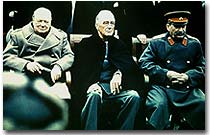
Prime Minister Churchill, President Roosevelt, and Premier Stalin meet at Yalta to discuss post-war Europe. It was at both the Yalta and Dumbarton Oaks conferences that the framework for the United Nations was devised.
In 1945, one major war ended and another began.
The Cold War lasted about 45 years. There were no direct military campaigns between the two main antagonists, the United States and the Soviet Union. Yet billions of dollars and millions of lives were lost in the fight.
The United States became the leader of the free-market capitalist world. America and its allies struggled to keep the communist, totalitarian Soviet Union from expanding into Europe, Asia, and Africa. Theaters as remote as Korea and Vietnam, Cuba and Grenada, Afghanistan and Angola, became battlegrounds between the two ideologies. One postwar pattern quickly became clear. The United States would not retreat into its former isolationist stance as long as there was a Cold War to wage.
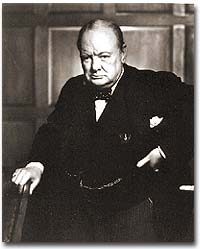
Winston Churchill's 1946 speech to Westminster University in Missouri contained the first reference to the communism of Eastern Europe as an "iron curtain."
The long-term causes of the Cold War are clear. Western democracies had always been hostile to the idea of a communist state. The United States had refused recognition to the USSR for 16 years after the Bolshevik takeover. Domestic fears of communism erupted in a Red Scare in America in the early Twenties. American business leaders had long feared the consequences of a politically driven workers' organization. World War II provided short-term causes as well.
There was hostility on the Soviet side as well. Twenty million Russian citizens perished during World War II. Stalin was enraged that the Americans and British had waited so long to open a front in France. This would have relieved pressure on the Soviet Union from the attacking Germans. Further, The United States terminated Lend-Lease aid to the Soviet Union before the war was complete. Finally, the Soviet Union believed in communism.
Stalin made promises during the war about the freedom of eastern Europe on which he blatantly reneged. At the Yalta Conference, the USSR pledged to enter the war against Japan no later than three months after the conclusion of the European war. In return, the United States awarded the Soviets territorial concessions from Japan and special rights in Chinese Manchuria.
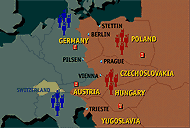 This map depicts the situation in Europe around the time of V-E Day. Soviet troops (in red) were able to secure Eastern Europe, while the other Allies worked to win the West. |
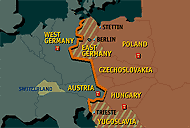 Europe in 1946 was becoming increasingly divided by the "iron curtain" seen in this map. Countries to the east of the orange line remained — or became — communist following World War II. |
When the Soviet Union entered the war between the bombings of Hiroshima and Nagasaki, the United States no longer needed their aid, but Stalin was there to collect on Western promises. All these factors contributed to a climate of mistrust that heightened tensions at the outbreak of the Cold War.
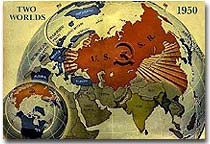
For most of the second half of the 20th century, the USSR and the United States were engaged in a Cold War of economic and diplomatic struggles. The communist bloc, as it appeared in 1950, included countries to the west and southeast of the Soviet Union.
At Potsdam, the Allies agreed on the postwar outcome for Nazi Germany. After territorial adjustments, Germany was divided into four occupation zones with the United States, Great Britain, France, and the Soviet Union each administering one. Germany was to be democratized and de-Nazified. Once the Nazi leaders were arrested and war crimes trials began, a date would be agreed upon for the election of a new German government and the withdrawal of Allied troops.
This process was executed in the zones held by the western Allies. In the eastern Soviet occupation zone, a puppet communist regime was elected. There was no promise of repatriation with the west. Soon such governments, aided by the Soviet Red Army came to power all across eastern Europe. Stalin was determined to create a buffer zone to prevent any future invasion of the Russian heartland.
Winston Churchill remarked in 1946 that an "iron curtain had descended across the continent."






